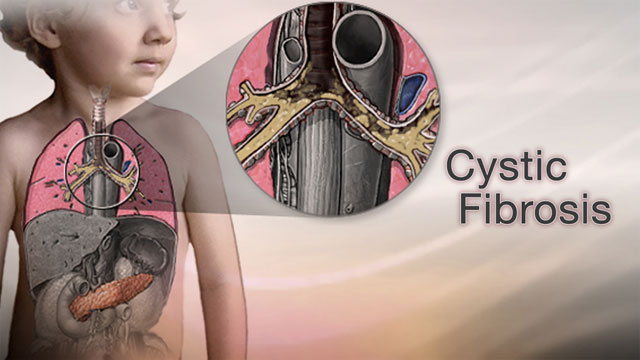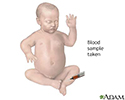Neonatal cystic fibrosis screening test
Cystic fibrosis screening - neonatal; Immunoreactive trypsinogen; IRT test; CF - screening
Neonatal cystic fibrosis screening is a blood test that screens newborns for cystic fibrosis (CF).

How the Test is Performed
A sample of blood is either taken from the bottom of the baby's foot or a vein in the arm. A tiny drop of blood is collected onto a piece of filter paper and allowed to dry. The dried blood sample is sent to a lab for analysis.
The blood sample is examined for increased levels of immunoreactive trypsinogen (IRT). This is a protein produced by the pancreas that is linked to CF.
How the Test will Feel
The brief feeling of discomfort will probably cause your baby to cry.
Why the Test is Performed
Cystic fibrosis is a disease that is usually passed down through families. CF causes thick, sticky mucus to build up in the lungs and parts of the digestive tract. It can lead to breathing and digestive problems.
Children with CF who are diagnosed early in life and start treatment at a young age may have better nutrition, growth, and lung function. This screening test helps health care providers identify children with CF before they have symptoms.
Some states include this test in the routine newborn screening tests that are done before the baby leaves the hospital.
If you live in a state that does not perform routine CF screening, your provider will explain whether testing is needed.
Other tests that look for genetic changes known to cause CF may also be used to screen for CF.
Normal Results
If the test result is negative, the child likely does not have CF. If the test result is negative but the baby has symptoms of CF, further testing will likely be done.
What Abnormal Results Mean
An abnormal (positive) result suggests that your child may have CF. But it is important to remember that a positive screening test does not diagnose CF. If your child's test is positive, more tests will be done to confirm the possibility of CF.
- Sweat chloride test is the standard diagnostic test for CF. A high salt level in the person's sweat is a sign of the disease.
- Genetic testing may also be done.
Not all children with a positive result have CF.
Risks
Risks associated with the test include:
- Infection (a slight risk any time the skin is broken)
- Anxiety over false positive results
- False reassurance over false negative results
References
Egan ME, Schechter MS, Voynow JA. Cystic fibrosis. In: Kliegman RM, St. Geme JW, Blum NJ, et al, eds. Nelson Textbook of Pediatrics. 22nd ed. Philadelphia, PA: Elsevier; 2025:chap 454.
Lo SF, Roper SM. Laboratory testing in infants and children. In: Kliegman RM, St. Geme JW, Blum NJ, et al, eds. Nelson Textbook of Pediatrics. 22nd ed. Philadelphia, PA: Elsevier; 2025:chap 769.
Review Date: 4/1/2024





